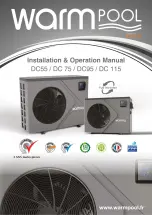
28
Sequence of operation — 38AQS008 outdoor
unit with 40RMQ008 indoor unit
When power is supplied to unit, the transformer (TRAN) is
energized. The crankcase heater is also energized.
Cooling —
With the thermostat subbase in the cooling
position, and when the space temperature comes within
2° F of the cooling set point, the thermostat makes circuit
R-O. This energizes the reversing valve solenoid (RVS) and
places the unit in standby condition for cooling.
As the space temperature continues to rise, the second
stage of the thermostat makes, closing circuit R-Y. When
compressor time delay (5 ± 2 minutes) is completed, a cir-
cuit is made to contactor (C), starting the compressor
(COMP) and outdoor-fan motor (OFM). Circuit R-G is
made at the same time, energizing the indoor-fan contac-
tor (IFC) and starting the indoor-fan motor (IFM) after one-
second delay.
When the thermostat is satisfied, contacts open, deener-
gizing C. The COMP, IFM, and OFM stop.
Heating —
On a call for heat, thermostat makes circuits
R-Y and R-G. When compressor time delay (5 ± 2 min-
utes) is completed, a circuit is made to C, starting COMP
and OFM. Circuit R-G also energizes IFC and starts IFM
after a 1-second delay.
Should room temperature continue to fall, circuit R-W is
made through second-stage thermostat bulb. If optional
electric heat package is used, a relay is energized, bringing
on supplemental electric heat. When thermostat is satis-
fied, contacts open, deenergizing contactor and relay;
motors and heaters deenergize.
Defrost —
Defrost board (DB) is a time and temperature
control, which includes a field-selectable time period
between checks for frost (30, 50, and 90 minutes). Elec-
tronic timer and defrost cycle start only when contactor is
energized and defrost thermostat (DFT) is closed (below
28 F [––2.2 C]).
Defrost mode is identical to Cooling mode, except
outdoor-fan motor (OFM) stops and a bank of supplemen-
tal electric heat turns on to warm air supplying the condi-
tioned space. Defrost mode is terminated when the DFT
reaches 65 F (18.3 C).
Sequence of operation — 38AQS012,016
outdoor unit with 40RMQ012,016 indoor
unit
Assume the power is on and the thermostat is set at
SYSTEM AUTO, FAN AUTO, and desired temperature.
Cooling —
If power to unit has been off for an extended
period of time, energize crankcase heater at least 24 hours
prior to starting compressor.
The indoor fans, outdoor fans, and compressor start
within 5 minutes (due to compressor time delay) on com-
mand from the controlling thermostat in either the Cooling
or the Heating mode of operation. When first stage cool-
ing is required, thermostat (TC1) closes, causing the heat
pump to start with an unloaded compressor. When TC2
closes, demanding additional cooling, the compressor
loads. In a system with a one-stage thermostat, the unit
may be wired so the compressor starts fully loaded. The
RVS (reversing valve solenoid) is deenergized during Cool-
ing mode operation.
Heating
First stage — When the thermostat (TH1) calls for heating,
the indoor-fan motor, outdoor-fan motors, and the com-
pressor (fully loaded) are energized. The RVS is energized
in the heating mode.
Second stage — If additional heating is required, TH2 on
the thermostat closes, causing the auxiliary heat supply
(i.e., electric resistance heat) to be energized in 1 or
2 stages depending on the number of stages available and
whether the outdoor thermostats are closed.
Defrost cycle —
Defrost is initiated by a timer which may
be set to 30, 50, or 90 minutes. The cycle begins when the
defrost timer motor contacts close for 20 seconds. If
the defrost thermostat is closed, the reversing valve and
outdoor-air fans are deenergized. The unit operates on this
modified Cooling mode to defrost the coil. The defrost
cycle continues until the defrost thermostat or defrost high
pressure switch opens or 10 minutes have elapsed.
When the unit is in the defrost cycle, electric resistance
heat is energized to prevent cold air recirculation during
this modified Cooling mode.
Air circulation —
When the fan switch is at FAN ON, the
indoor-air fans operate continuously to provide ventilation.
The thermostat operates the other components as
described above.
Emergency heat cycle —
If the compressor is inopera-
tive due to a tripped safety device, the second stage of the
thermostat automatically energizes the indoor-air fan and
the electric resistance heaters.
If desired, the compressor can be manually locked out by
setting the thermostat for emergency heat. In this instance,
the emergency heat indicator light on the thermostat
assembly is illuminated.
Controls
Содержание 40RMQ
Страница 13: ...13 38AQS012 016 ...
Страница 30: ...30 Typical control wiring schematic cont 38AQS008 ...
Страница 31: ...31 38AQS012 016 208 230 3 60 ...
Страница 32: ...32 Typical control wiring schematic cont 38AQS012 016 460 3 60 575 3 60 COMPONENT ARRANGEMENT ...
















































